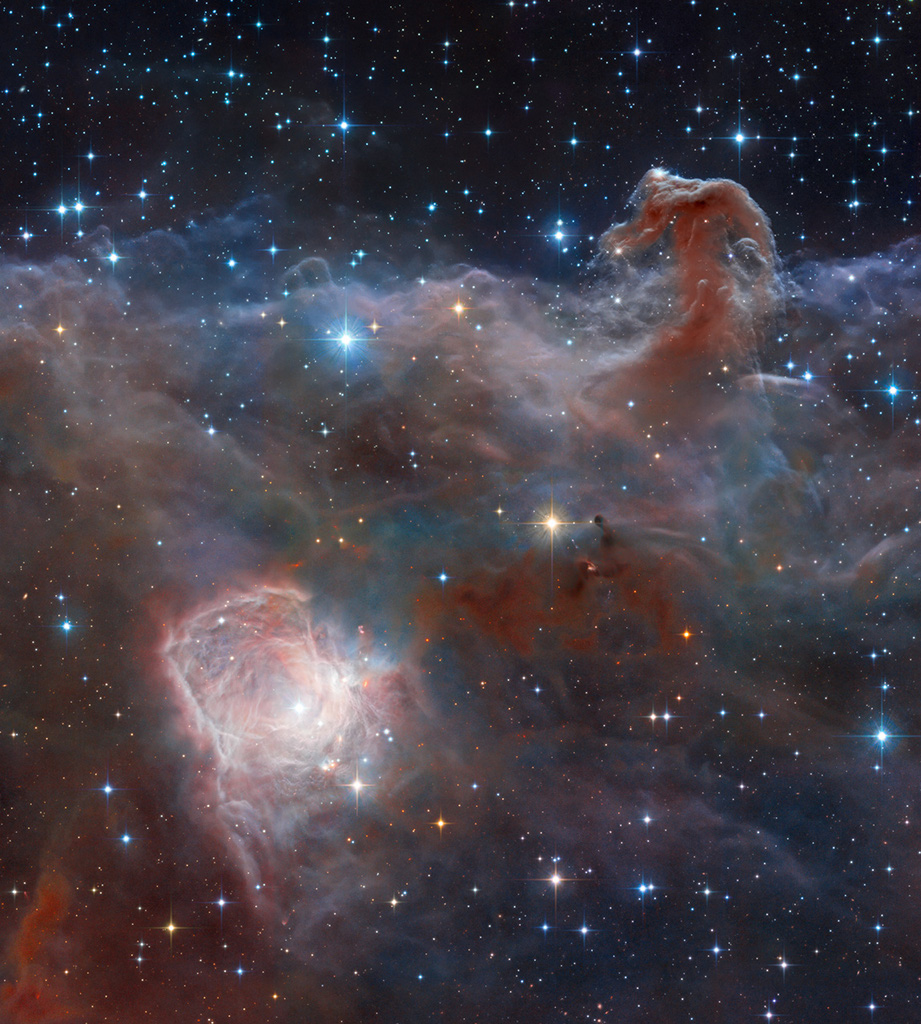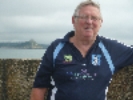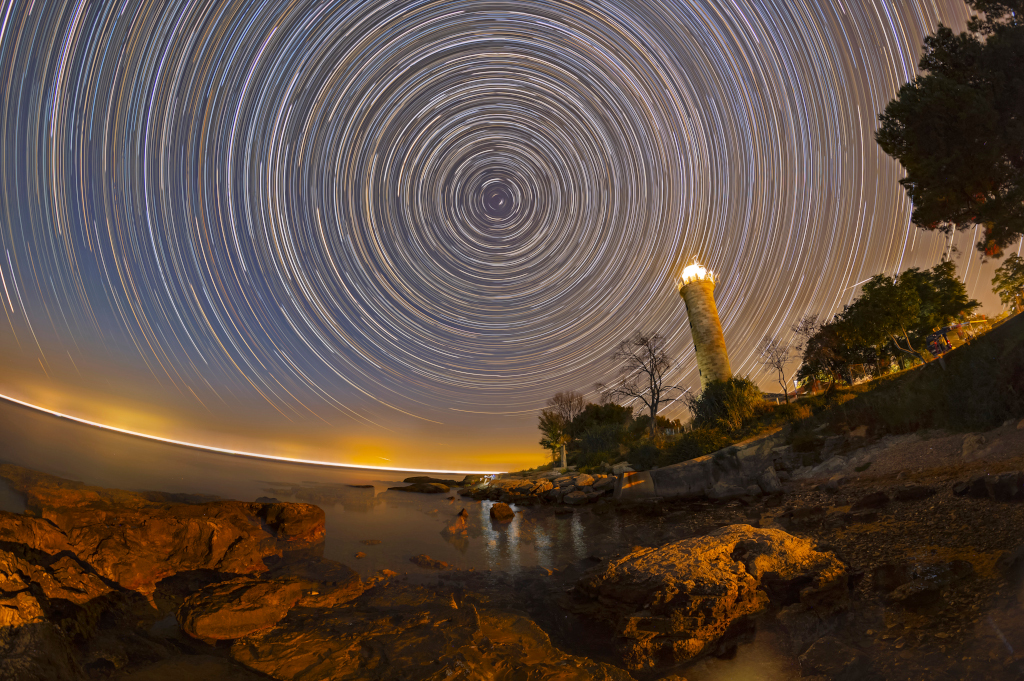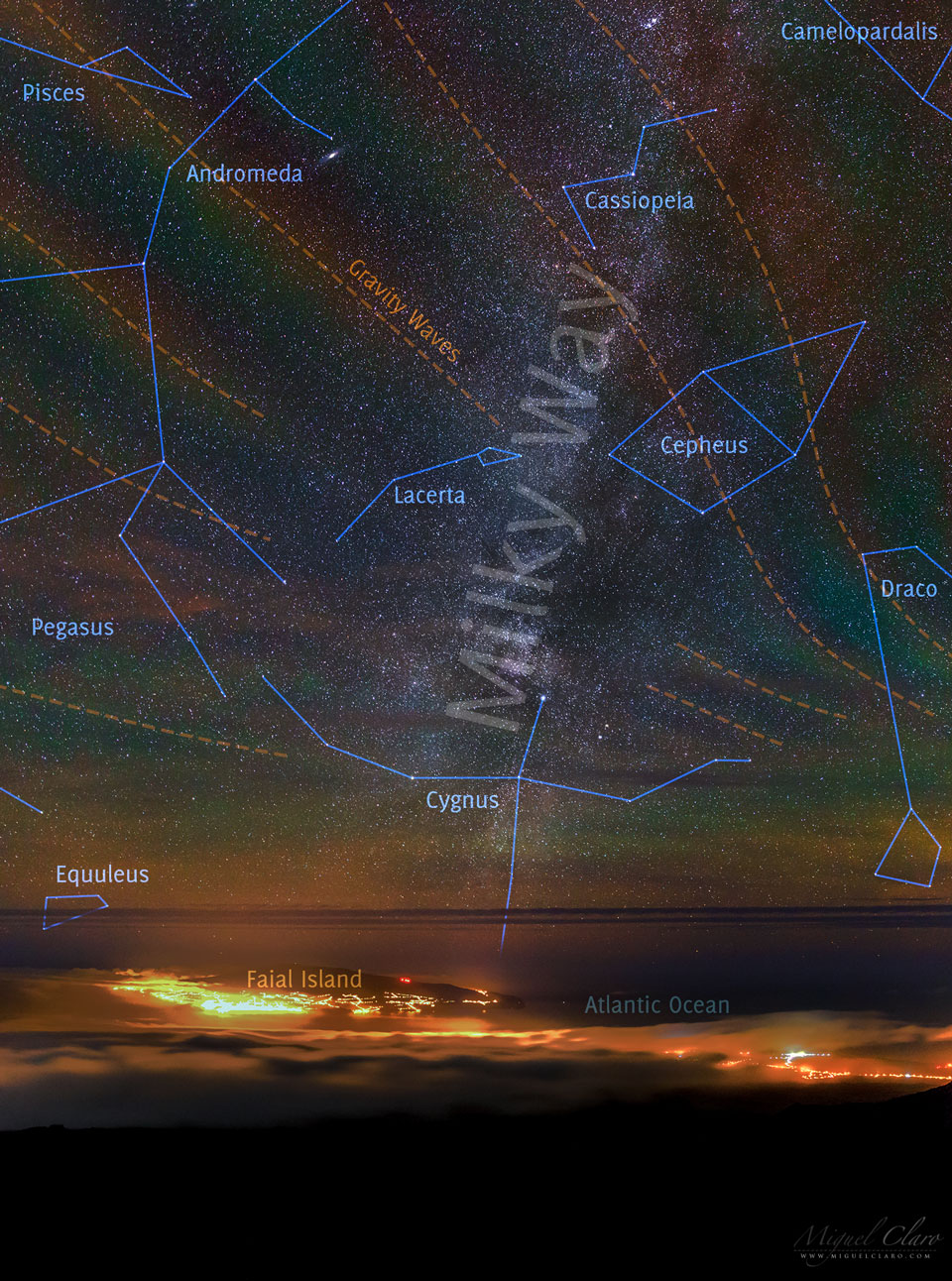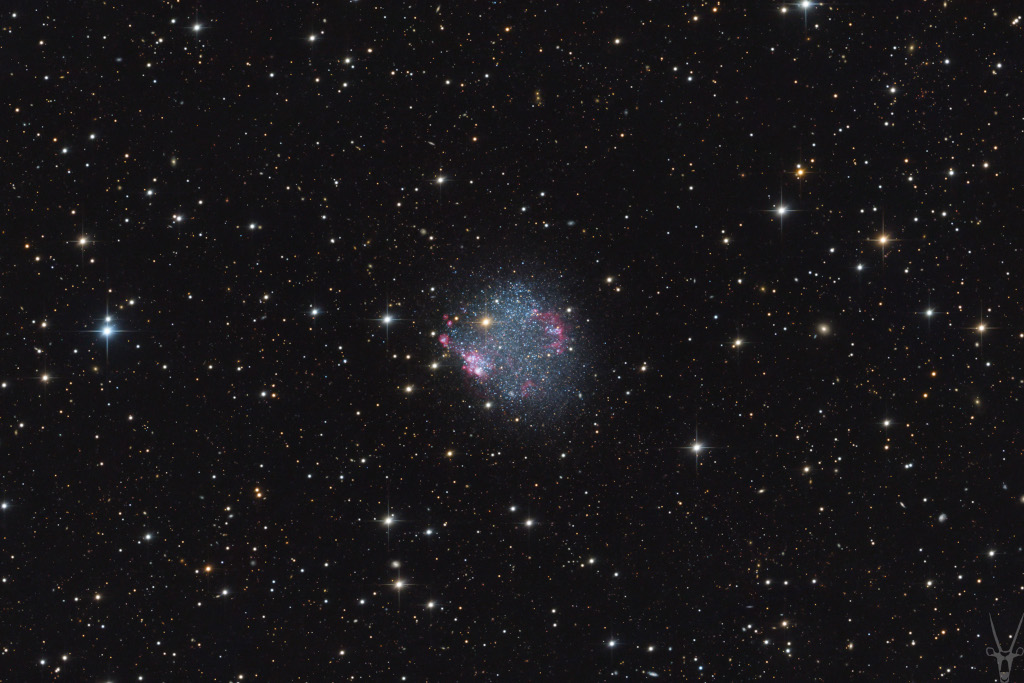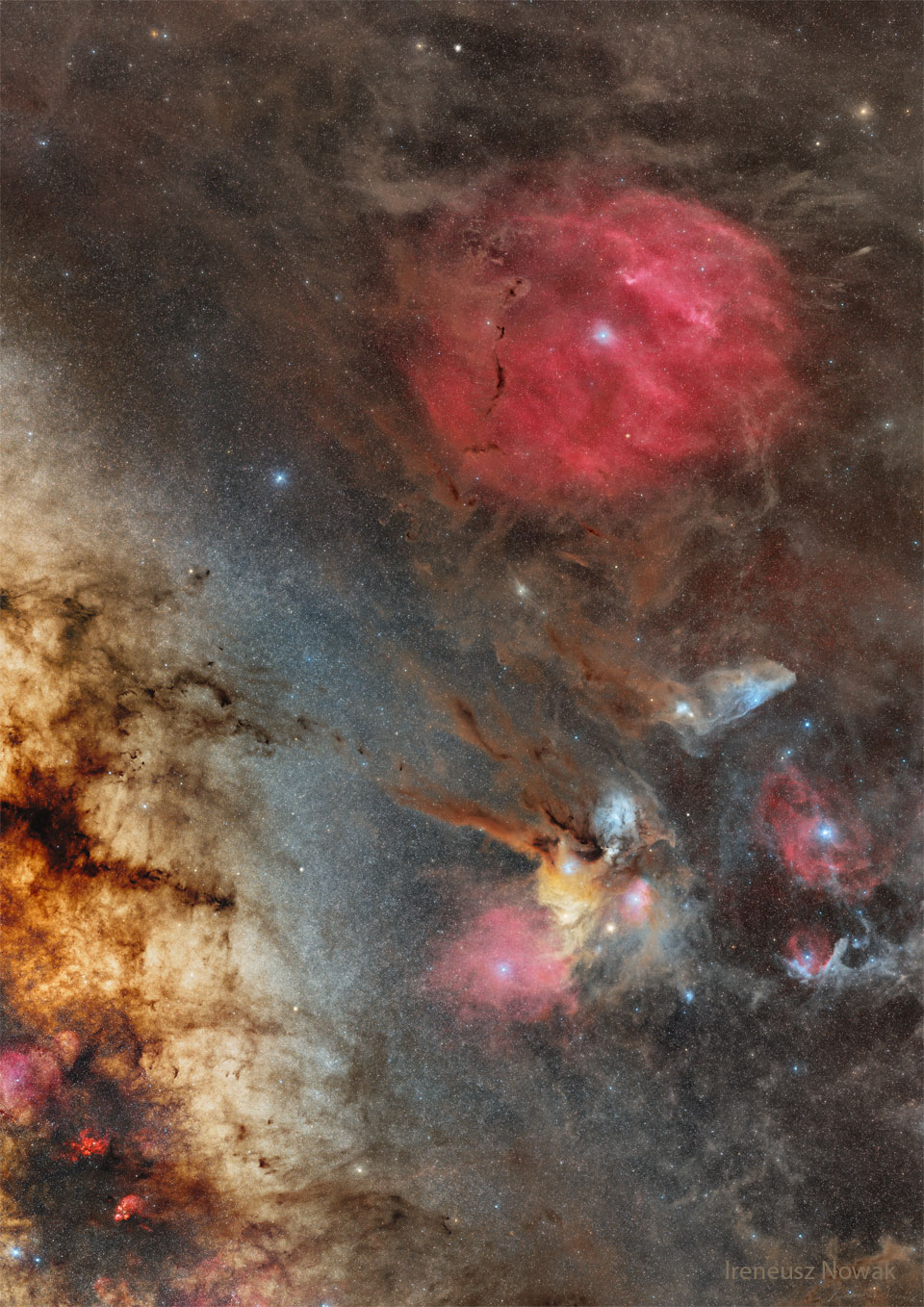
|
| Title: NASA pics | |
| Grapevine50sRoost > ~GENERAL~ > GENERAL DISCUSSION | Go to subcategory: |
| Author | Content |
|
zxxlyzq
|
|
|
Date Posted:09/03/2018 12:10 PMCopy HTML Composition and Processing: Robert Gendler Image Data: ESO, VISTA, HLA, Hubble Heritage Team (STScI/AURA) Explanation: Combined image data from the massive, ground-based VISTA telescope and the Hubble Space Telescope was used to create this wide perspective of the interstellar landscape surrounding the famous Horsehead Nebula. Captured at near-infrared wavelengths, the region's dusty molecular cloud sprawls across the scene that covers an angle about two-thirds the size of the Full Moon on the sky. Left to right the frame spans just over 10 light-years at the Horsehead's estimated distance of 1,600 light-years. Also known as Barnard 33, the still recognizable Horsehead Nebula stands at the upper right, the near-infrared glow of a dusty pillar topped with newborn stars. Below and left, the bright reflection nebula NGC 2023 is itself the illuminated environs of a hot young star. Obscuring clouds below the base of the Horsehead and on the outskirts of NGC 2023 show the tell-tale far red emission of energetic jets, known as Herbig-Haro objects, also associated with newborn stars. |
|
|
Megan57
|
Share to:





 #211
#211
|
|
Re:NASA pics Date Posted:09/06/2025 7:26 AMCopy HTML
|
|
|
Megan57
|
Share to:





 #212
#212
|
|
Re:NASA pics Date Posted:09/06/2025 7:26 AMCopy HTML
|
|
|
Rockymz
|
Share to:





 #213
#213
|
|
Re:NASA pics Date Posted:09/06/2025 7:17 AMCopy HTML
Image Credit: M. Drechsler, Y. Sainty, A. Soto, N. Martino, L. Leroux-Gere, S. Khallouqui, & A. Kaeouach; Text: Ogetay Kayali (Michigan Tech U.) Explanation: Can you identify this celestial object? Likely not — because this is a discovery image. Massive stars forge heavy elements in their cores and, after a few million years, end their lives in powerful supernova explosions. These remnants cool relatively quickly and fade, making them difficult to detect. To uncover such faint, previously unknown supernova remnants, a dedicated group of amateur astrophotographers searched through sky surveys for possible supernova remnant candidates. The result: the first-ever image of supernova remnant G115.5+9.1 — named Scylla by its discoverers—glowing faintly in the constellation of the mythological King of Aethiopia: Cepheus. Emission from hydrogen atoms in the remnant is shown in red, and faint emission from oxygen is shown in hues of blue. Surprisingly, another discovery lurked to the upper right: a faint, previously unknown planetary nebula candidate. In keeping with mythological tradition, it was named Charybdis (Sai 2) — a nod to the ancient Greek expression "caught between Scylla and Charybdis" from Homer’s Odyssey. |
|
|
Megan57
|
Share to:





 #214
#214
|
|
Re:NASA pics Date Posted:08/06/2025 8:06 AMCopy HTML
|
|
|
Rockymz
|
Share to:





 #215
#215
|
|
Re:NASA pics Date Posted:08/06/2025 7:48 AMCopy HTML Image Credit: ESA/Hubble & NASA Explanation: From our vantage point in the Milky Way Galaxy, we see NGC 3344 face-on. Nearly 40,000 light-years across, the big, beautiful spiral galaxy is located just 20 million light-years away in the constellation of Leo Minor. This multi-color Hubble Space Telescope close-up of NGC 3344 includes remarkable details from near infrared to ultraviolet wavelengths. The frame extends some 15,000 light-years across the spiral's central regions. From the core outward, the galaxy's colors change from the yellowish light of old stars in the center to young blue star clusters and reddish star forming regions along the loose, fragmented spiral arms. Of course, the bright stars with a spiky appearance are in front of NGC 3344 and lie well within our own Milky Wa |
|
|
Megan57
|
Share to:





 #216
#216
|
|
Re:NASA pics Date Posted:07/06/2025 8:33 AMCopy HTML Amazing Rocky thank you x |
|
|
Rockymz
|
Share to:





 #217
#217
|
|
Re:NASA pics Date Posted:07/06/2025 8:32 AMCopy HTML Image Credit: NASA, JPL-Caltech, MSSS Explanation: On the Mars rover's mission Sol 46 or Earth date April 6, 2021, Perseverance held out a robotic arm to take its first selfie on Mars. The WATSON camera at the end of the arm was designed to take close-ups of Martian rocks and surface details though, and not a quick snap shot of friends and smiling faces. In the end, teamwork and weeks of planning on Mars time was required to program a complex series of exposures and camera motions to include Perseverance and its surroundings. The resulting 62 frames were composed into a detailed mosaic, one of the most complicated Mars rover selfies ever taken. In this version of the selfie, the rover's Mastcam-Z and SuperCam instruments are looking toward WATSON and the end of the rover's outstretched arm. About 4 meters (13 feet) from Perseverance is a robotic companion, the Mars Ingenuity helicopter. Perseverance has now spent over 1,500 sols exploring the surface of the Red Planet. On Earth date January 18, 2024, Ingenuity made its 72nd and final flight through the thin Martian atmosphere. |
|
|
Rockymz
|
Share to:





 #218
#218
|
|
Re:NASA pics Date Posted:06/06/2025 7:56 AMCopy HTML Image Credit & Copyright: Mike Selby Explanation: The bright clusters and nebulae of planet Earth's night sky are often given the names of flowers or insects, and its whopping 3 light-year wingspan, NGC 6302 is no exception. With an estimated surface temperature of about 250,000 degrees C, the central star of the planetary nebula is transforming into a white dwarf star, becoming exceptionally hot, and shining brightly in ultraviolet light. The central star is hidden from direct view by a torus of dust, but its energetic ultraviolet light ionizes atoms in the nebula. In this sharp, telescopic view composed with narrowband image data, the ionized hydrogen and doubly ionized oxygen atoms are shown in their characteristic red and blue-green hues to reveal a stunning complex of knots and filaments within the nebula's wing-like bipolar outflows. NGC 6302 lies about 4,000 light-years away in the arachnologically correct constellation of the Scorpion (Scorpius). |
|
|
Megan57
|
Share to:





 #219
#219
|
|
Re:NASA pics Date Posted:06/06/2025 6:24 AMCopy HTML Amazing Rocky x |
|
|
MarilynH
|
Share to:





 #220
#220
|
|
Re:NASA pics Date Posted:06/06/2025 4:40 AMCopy HTML Fabulous time exposure Rocky! |
|
|
DirtyDancer1957
|
Share to:





 #221
#221
|
|
Re:NASA pics Date Posted:05/06/2025 6:06 PMCopy HTML wow! Thank you Rocky. |
|
|
Rockymz
|
Share to:





 #222
#222
|
|
Re:NASA pics Date Posted:05/06/2025 6:40 AMCopy HTML Image Credit & Copyright: Branko Nadj Explanation: Savudrija lighthouse shines along the coast near the northern end of the Istrian peninsula in this well-composed night skyscape. A navigational aid for sailors on the Adriatic Sea, the historic lighthouse was constructed in the early 19th century. But an even older aid to navigation shines in the sky above, Polaris, alpha star of the constellation Ursa Minor and also known as the North Star. In this scene Polaris forms the shortest bright arc near the North Celestial Pole, the extension of Earth's axis of rotation into space. Of course, the North Celestial Pole lies exactly at the center of all the concentric startrails. The composite image is a digital stack of 400 exposures, each 30 seconds long, taken with camera and tripod fixed to a rotating planet. |
|
|
Megan57
|
Share to:





 #223
#223
|
|
Re:NASA pics Date Posted:05/06/2025 6:24 AMCopy HTML Amazing Rocky x |
|
|
Rockymz
|
Share to:





 #224
#224
|
|
Re:NASA pics Date Posted:04/06/2025 8:03 AMCopy HTML
Image Credit: NSF, DOE, Rubin Obs., Paulo Assunção Lago (Rubin Obs.) Explanation: Is the sky the same every night? No -- the night sky changes every night in many ways. To better explore how the night sky changes, the USA's NSF and DOE commissioned the Vera C. Rubin Observatory in Cerro Pachón, Chile. In final testing before routine operations, Rubin will begin to explore these nightly changes -- slight differences that can tell us much about our amazing universe and its surprising zoo of objects. With a mirror over 8 meters across, Rubin will continually reimage the entire visible sky every few nights to discover new supernovas, potentially dangerous asteroids, faint comets, and variable stars -- as well as mapping out the visible universe's large-scale structure. Pictured, the distant central band of our Milky Way Galaxy appears to flow out from the newly operational observatory. Taken last month, the featured picture is a composite of 21 images across the night sky, capturing airglow on the horizon and the Small Magellanic Cloud galaxy on the lower left. |
|
|
Megan57
|
Share to:





 #225
#225
|
|
Re:NASA pics Date Posted:04/06/2025 6:05 AMCopy HTML
|
|
|
Rockymz
|
Share to:





 #226
#226
|
|
Re:NASA pics Date Posted:03/06/2025 8:35 AMCopy HTML
Image Credit & Copyright: Miguel Claro (TWAN); Rollover Annotation: Judy Schmidt Explanation: Why would the sky glow like a giant repeating rainbow? Airglow. Now, air glows all of the time, but it is usually hard to see. A disturbance however -- like an approaching storm -- may cause noticeable rippling in the Earth's atmosphere. These gravity waves are oscillations in air analogous to those created when a rock is thrown in calm water. The long-duration exposure nearly along the vertical walls of airglow likely made the undulating structure particularly visible. OK, but where do the colors originate? The deep red glow likely originates from OH molecules about 87 kilometers high, excited by ultraviolet light from the Sun. The orange and green airglow is likely caused by sodium and oxygen atoms slightly higher up. The featured image was captured during a climb up Mount Pico in the Azores of Portugal. Ground lights originate from the island of Faial in the Atlantic Ocean. A spectacular sky is visible through this banded airglow, with the central band of our Milky Way Galaxy running up the image center, and M31, the Andromeda Galaxy, visible near the top lef |
|
|
Megan57
|
Share to:





 #227
#227
|
|
Re:NASA pics Date Posted:03/06/2025 6:25 AMCopy HTML Amazing Rocky x |
|
|
Rockymz
|
Share to:





 #228
#228
|
|
Re:NASA pics Date Posted:02/06/2025 7:56 AMCopy HTML Image Credit & Copyright: Abdullah Alharbi Explanation: Wisps like this are all that remain visible of a Milky Way star. About 7,000 years ago that star exploded in a supernova, leaving the Veil Nebula. At the time, the expanding cloud was likely as bright as a crescent Moon, remaining visible for weeks to people living at the dawn of recorded history. Today, the resulting supernova remnant, also known as the Cygnus Loop, has faded and is now visible only through a small telescope directed toward the constellation of the Swan (Cygnus). The remaining Veil Nebula is physically huge, however, and even though it lies about 1,400 light-years distant, it covers over five times the size of the full Moon. The featured picture was taken in Kuwait in mid-2024 and features light emitted by hydrogen in red and oxygen in blue. In deep images of the complete Veil Nebula like this, even studious readers might not be able to identify the iconic filaments. |
|
|
Megan57
|
Share to:





 #229
#229
|
|
Re:NASA pics Date Posted:02/06/2025 7:00 AMCopy HTML
|
|
|
Rockymz
|
Share to:





 #230
#230
|
|
Re:NASA pics Date Posted:01/06/2025 7:51 AMCopy HTML Image Credit: NASA, ESA, Hubble, HLA; Processing & Copyright: Domingo Pestana Explanation: What's happening to this spiral galaxy? Although details remain uncertain, it surely has to do with an ongoing battle with its smaller galactic neighbor. The featured galaxy is labelled UGC 1810 by itself, but together with its collisional partner is known as Arp 273. The overall shape of UGC 1810 -- in particular its blue outer ring -- is likely a result of wild and violent gravitational interactions. This ring's blue color is caused by massive stars that are blue hot and have formed only in the past few million years. The inner galaxy appears older, redder, and threaded with cool filamentary dust. A few bright stars appear well in the foreground, unrelated to UGC 1810, while several galaxies are visible well in the background. Arp 273 lies about 300 million light years away toward the constellation of Andromeda. Quite likely, UGC 1810 will devour its galactic sidekick over the next billion years and settle into a classic spiral form. |
|
|
Megan57
|
Share to:





 #231
#231
|
|
Re:NASA pics Date Posted:31/05/2025 7:14 AMCopy HTML Amazing Rocky x |
|
|
Rockymz
|
Share to:





 #232
#232
|
|
Re:NASA pics Date Posted:31/05/2025 7:12 AMCopy HTML Image Credit & Copyright: Marcella Giulia Pace Explanation: On May 7, the Sun setting behind a church bell tower was captured in this filtered and manipulated digital skyscape from Ragusa, Sicily, planet Earth. In this version of the image the colors look bizarre. Still, an intriguing optical illusion known as an afterimage can help you experience the same scene with a more natural looking appearance. To try it, find the sunspots of active region AR4079 grouped near the bottom of the blue solar disk. Relax and stare at the dark sunspot group for about 30 seconds, then close your eyes or shift your gaze to a plain white surface. In a moment an afterimage of the sunset should faintly appear. But the afterimage sunset will have this image's complementary colors and a more normal yellow Sun against a familiar blue sky. |
|
|
Rockymz
|
Share to:





 #233
#233
|
|
Re:NASA pics Date Posted:30/05/2025 8:09 AMCopy HTML Image Credit & Copyright: Tunc Tezel (TWAN) Explanation: This composite of images spaced a weather-permitting 5 to 9 days apart, from 2024 September 19 (top right) through 2025 May 18 (bottom left), faithfully traces ruddy-colored Mars as it makes a clockwise loop through the constellations Gemini and Cancer in planet Earth's night sky. You can connect the dots and dates with your cursor over the image, but be sure to check out this animation of the Red Planet's 2024/25 retrograde motion. Of course Mars didn't actually reverse the direction of its orbit. Instead, the apparent backwards motion with respect to the background stars is a reflection of the orbital motion of Earth itself. Retrograde motion can be seen each time Earth overtakes and laps planets orbiting farther from the Sun, the Earth moving more rapidly through its own relatively close-in orbit. In this case Mars' apparent eastward motion began to reverse around December 8, when it seemed to linger near open star cluster M44 in Cancer. After wandering back to the west, under Gemini's bright stars Castor and Pollux, Mars returned to pose near M44 by early May. At its brightest near opposition on 2025 January 16, Mars was a mere 96 million kilometers away. |
|
|
Megan57
|
Share to:





 #234
#234
|
|
Re:NASA pics Date Posted:30/05/2025 6:23 AMCopy HTML Beautiful Rocky x |
|
|
Rockymz
|
Share to:





 #235
#235
|
|
Re:NASA pics Date Posted:29/05/2025 7:55 AMCopy HTML Image Credit & Copyright: Franz Hofmann, Gemsbock Observatory Explanation: Grand spiral galaxies often seem to get all the attention, flaunting young, bright, blue star clusters and pinkish star forming regions along graceful, symmetric spiral arms. But small galaxies form stars too, like irregular dwarf galaxy Sextans A. Its young star clusters and star forming regions are gathered into a gumdrop-shaped region a mere 5,000 light-years across. Seen toward the navigational constellation Sextans, the small galaxy lies some 4.5 million light-years distant. That puts it near the outskirts of the local group of galaxies, that includes the large, massive spirals Andromeda and our own Milky Way. Brighter Milky Way foreground stars appear spiky and yellowish in this colorful telescopic view of Sextans A. |
|
|
Megan57
|
Share to:





 #236
#236
|
|
Re:NASA pics Date Posted:29/05/2025 6:03 AMCopy HTML
|
|
|
DirtyDancer1957
|
Share to:





 #237
#237
|
|
Re:NASA pics Date Posted:28/05/2025 10:53 AMCopy HTML Stunning! |
|
|
Rockymz
|
Share to:





 #238
#238
|
|
Re:NASA pics Date Posted:28/05/2025 7:41 AMCopy HTML Image Credit: NASA, ESA, Hubble Heritage (STScI / AURA) / Hubble-Europe Collaboration Acknowledgment: D. Padgett (GSFC), T. Megeath (University of Toledo), B. Reipurth (University of Hawaii) Explanation: This might look like a double-bladed lightsaber, but these two cosmic jets actually beam outward from a newborn star in a galaxy near you. Constructed from Hubble Space Telescope image data, the stunning scene spans about half a light-year across Herbig-Haro 24 (HH 24), some 1,300 light-years or 400 parsecs away in the stellar nurseries of the Orion B molecular cloud complex. Hidden from direct view, HH 24's central protostar is surrounded by cold dust and gas flattened into a rotating accretion disk. As material from the disk falls toward the young stellar object, it heats up. Opposing jets are blasted out along the system's rotation axis. Cutting through the region's interstellar matter, the narrow, energetic jets produce a series of glowing shock fronts along their path. |
|
|
Megan57
|
Share to:





 #239
#239
|
|
Re:NASA pics Date Posted:28/05/2025 7:05 AMCopy HTML Amazing Rocky x |
|
|
Rockymz
|
Share to:





 #240
#240
|
|
Re:NASA pics Date Posted:27/05/2025 8:52 AMCopy HTML Image Credit & Copyright: Ireneusz Nowak Explanation: Behold one of the most photogenic regions of the night sky, captured impressively. Featured, the band of our Milky Way Galaxy runs diagonally along the bottom-left corner, while the colorful Rho Ophiuchi cloud complex is visible just right of center and the large red circular Zeta Ophiuchi Nebula appears near the top. In general, red emanates from nebulas glowing in the light of excited hydrogen gas, while blue marks interstellar dust preferentially reflecting the light of bright young stars. Thick dust usually appears dark brown. Many iconic objects of the night sky appear, including (can you find them?) the bright star Antares, the globular star cluster M4, and the Blue Horsehead nebula. This wide field composite, taken over 17 hours, was captured from South Africa last June. |





